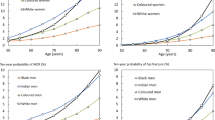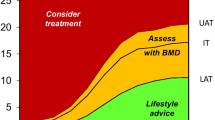Abstract
Summary
The Irish Fracture Risk Assessment (FRAX) tool is the first fracture prediction model that has been calibrated using national hip fracture incidence data and Irish mortality rates. The Irish FRAX tool can be used to identify intervention thresholds for Ireland based on the fracture probability equivalent to that of a woman with a prior fracture.
Objectives
The objective of the study is to describe the 10-year probability of osteoporotic fracture in men and women in Ireland by using the Irish version of the FRAX tool and to develop FRAX-based intervention thresholds.
Methods
The FRAX model for Ireland was constructed from the age- and sex-stratified hip fracture incidence rates from 2008 to 2010. For other major osteoporotic fractures, incidence rates were imputed, using age- and sex-specific Swedish ratios for hip to osteoporotic fracture risks. Lifetime fracture probabilities and 10-year probabilities of a major osteoporotic fracture were calculated in women to determine potential intervention thresholds.
Results
Based on the incidence of hip fracture and mortality, the average lifetime probability of hip fracture from the age of 50 years was 7.8 % in men and 18.2 % in women from Ireland. Probability-based intervention threshold derived from BMD T-scores were problematic. When a BMD T-score ≤ −2.5 standard deviations (SD) was used as an intervention threshold, the increase in risk associated with the BMD threshold decreased progressively with age such that, at the age of 80 years or more, a T-score of −2.5 SD was protective. The 10-year probability of a major osteoporotic fracture by age, equivalent to that of women with a previous fracture, rose with age, from 3.0 % at the age of 40 years to 30 % at the age of 90 years, and identified women at increased risk at all ages.
Conclusion
The Irish FRAX tool is the first fracture prediction model that has been calibrated using national hip fracture incidence data and Irish mortality rates.




Similar content being viewed by others
References
Hernlund E, Svedbom A, et al. (2013) Osteoporosis in the European Union: medical management, epidemiology and economic burden. A report prepared in collaboration with the International Osteoporosis Foundation (IOF) and the European Federation of Pharmaceutical Industry Associations (EFPIA). Arch Osteoporos, doi: 10.1007/s11657-013-0136-1
Svedbom A, Hernlund E, Ivergård M et al. (2013) Epidemiology and economic burden of osteoporosis in Ireland. Arch Osteoporos (in press)
McGowan B, Casey MC, Silke C, Whelan B, Bennett K (2012) Hospitalisations for fracture and associated costs between 2000 and 2009 in Ireland: a trend analysis. Osteoporos Int 24(3):849–857. doi:10.1007/s00198-012-2032-8
HSE (2013) Report of the National Steering Group on the prevention of falls in older people and the prevention and management of osteoporosis throughout life, 2008, strategy to prevent falls and fractures in Ireland's ageing population. http://www.hse.ie/eng/Publications/services/Older/Strategy_to_Prevent_Falls_and_Fractures_in_Ireland's_Ageing_Population_-_Full_report.pdf. Accessed February 2013
Kanis JA, Melton LJ, Christiansen C, Johnston C, Khaltaev N (1994) The diagnosis of osteoporosis. J Bone Miner Res 9:1137–1141
Marshall D, Johnell O, Wedel H (1996) Meta-analysis of how well measures of bone mineral density predict occurrence of osteoporotic fractures. Bmj 312(7041):1254–1259
Johnell O, Kanis JA, Oden A, Johansson H, de Laet C, Delmas P et al (2005) Predictive value of BMD for hip and other fractures. J Bone Miner Res 20(7):1185–1194
Irish Osteoporosis Society (2011) Osteoporosis guidelines for health professionals. pp 1–78. www.irishosteoporosis.ie. Accessed 20 April 2013
Kanis JA, Johnell O, Oden A, Johansson H, McCloskey E (2008) FRAX and the assessment of fracture probability in men and women from the UK. Osteoporos Int 19:385–397
Health Atlas Ireland. Health Intelligence Unit, HSE (2013) http://www.healthatlasireland.ie. Accessed April 2013
United Nations (2010) Population Division of the Department of Economic and Social Affairs of the United Nations Secretariat, World Population Prospects. http://esa.un.org/unpd/wpp/unpp/panel_indicators.htm. Accessed November 2011
CSO Central Statistics Office (2012) http://www.cso.ie/en/releasesandpublications/. Accessed 20 February 2012
Kanis JA, Hans D, Cooper C et al (2011) Interpretation and use of FRAX in clinical practice. Osteoporos Int 22:395–411
Kanis JA on behalf of the World Health Organization Scientific Group (2008b) Assessment of osteoporosis at the primary health-care level. Technical report. WHO Collaborating Centre, University of Sheffield. http://www.shef.ac.uk/FRAX. Accessed 26th September 2012
Kanis JA, Oden A, Johnell O et al (2007) The use of clinical risk factors enhances the performance of BMD in the prediction of hip and osteoporotic fractures in men and women. Osteoporos Int 18:1033–1046
Kanis JA, Johnell O, de Laet C, Jonsson B, Oden A, Ogelsby AK (2002) International variations in hip fracture probabilities: implications for risk assessment. J Bone Miner Res 17:1237–1244
Kanis JA, Odén A, McCloskey EV, Johansson H, Wahl D, Cyrus Cooper C, IOF Working Group on Epidemiology and Quality of Life (2012) A systematic review of hip fracture incidence and probability of fracture worldwide. Osteoporos Int 23:2239–2256
Lekamwasam S, Adachi JD, Agnusdei D, Bilezikian J, Boonen S, Borgstrom F et al (2012) A framework for the development of guidelines for the management of glucocorticoid-induced osteoporosis. Osteoporos Int 23:2257–2276
Kanis JA, McCloskey EV, Johansson H, Cooper C, Rizzoli R, Reginster JY (2013) European guidance for the diagnosis and management of osteoporosis in postmenopausal women. Osteoporos Int 24:23–57
Kanis JA, Oden A, Johnell O, Jonsson B, de Laet C, Dawson A (2001) The burden of osteoporotic fractures: a method for setting intervention thresholds. Osteoporos Int 12:417–427
Conflicts of Interest
None.
Author information
Authors and Affiliations
Corresponding author
Rights and permissions
About this article
Cite this article
McGowan, B., Kanis, J.A., Johansson, H. et al. Development and application of FRAX in the management of osteoporosis in Ireland. Arch Osteoporos 8, 146 (2013). https://doi.org/10.1007/s11657-013-0146-z
Received:
Accepted:
Published:
DOI: https://doi.org/10.1007/s11657-013-0146-z




